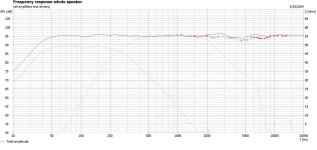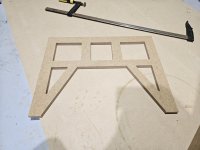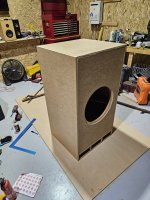Fair enough, they are pretty!
If building the best is the plan, would there be any sonic benefit to either off-setting the tweeter or making the baffle asymmetrical?

If building the best is the plan, would there be any sonic benefit to either off-setting the tweeter or making the baffle asymmetrical?
I had look at that speaker kit before i decideed to build something, i do like the look of them, that is an option.
Asymmetric tweeter placement or asymmetric baffle shape reduces coinciding of baffle edge diffraction effects.would there be any sonic benefit to either off-setting the tweeter or making the baffle asymmetrical?
Roundovers or chamfers reduce baffle edge diffraction peaks (and/or general baffle edge effects).
Edit - have a look at the response in this post (second image) showing a worst case scenario with tweeter having the same distance to three baffle edges:
https://www.diyaudio.com/community/...a-speaker-design-beginner.388191/post-7070975
Last edited:
Hi again,
Worst case scenarios maybe can happen sometimes but IMO it's not generally the case. In some of experiments of mine camfers actually made the situation worse, attached screen shot with simulation. Red dotted line is no camfers, black with camfers. Similar results have been measured. This depens on dimensions of baffle & positioning of mid/tweeter. Also rounding of edges can somewhat increase output to back side of the speaker which means more early reflections -> not good.
I think that rounding of egdes should be taken account to while designing crossovers and other elements but often it's importance is overstated nowadays.
Regards & good luck
Worst case scenarios maybe can happen sometimes but IMO it's not generally the case. In some of experiments of mine camfers actually made the situation worse, attached screen shot with simulation. Red dotted line is no camfers, black with camfers. Similar results have been measured. This depens on dimensions of baffle & positioning of mid/tweeter. Also rounding of edges can somewhat increase output to back side of the speaker which means more early reflections -> not good.
I think that rounding of egdes should be taken account to while designing crossovers and other elements but often it's importance is overstated nowadays.
Regards & good luck
Attachments
My worst case example was just to point out the benefit of unsymmetric tweeter-placement (which vermouth asked about).Worst case scenarios maybe can happen sometimes but IMO it's not generally the case.
In my opinion, cabinet edge diffraction can have a detrimental effect on speaker performance.
Here are some simulations. I simulated an ideal tweeter as a 30 mm diameter flat piston. First I show the response in an infinite baffle

Now I put that ideal tweeter in a rectangular baffle with 37mm radius edges. Here I show the horizontal polar responses in 10 degree increments.

Now here is the same rectangular baffle, but now the edges have a 1 mm radius, which is a sharp edge.

There is a measurable effect on the polar responses from 0 to ~70 degrees.
High frequency diffraction has an effect which goes beyond the frequency response impact. I believe it diminishes the 3-D presentation, and reduces the listener's ability to perceive a sense of spaciousness and localization. If the listening position is far from the speakers, and the sound field is mostly the reverberant / reflected sound, this impact may be negligible. But if the majority of the sound is direct sound (close listening distance), the impact of diffraction sources on the speaker baffle can be detected.
j.
Here are some simulations. I simulated an ideal tweeter as a 30 mm diameter flat piston. First I show the response in an infinite baffle
Now I put that ideal tweeter in a rectangular baffle with 37mm radius edges. Here I show the horizontal polar responses in 10 degree increments.
Now here is the same rectangular baffle, but now the edges have a 1 mm radius, which is a sharp edge.
There is a measurable effect on the polar responses from 0 to ~70 degrees.
High frequency diffraction has an effect which goes beyond the frequency response impact. I believe it diminishes the 3-D presentation, and reduces the listener's ability to perceive a sense of spaciousness and localization. If the listening position is far from the speakers, and the sound field is mostly the reverberant / reflected sound, this impact may be negligible. But if the majority of the sound is direct sound (close listening distance), the impact of diffraction sources on the speaker baffle can be detected.
j.
Hi,
Thanks for sharing your simulation. I tested it with program I am using and results seem to be similar, so there is an agreement.
I also tested against other box dimensions and it's apparent that diffraction effects are very sensitive to box width, height & placement of the tweeter.
This explains why in my case there was not much of a difference if edges are rounded or not.
Regards
Thanks for sharing your simulation. I tested it with program I am using and results seem to be similar, so there is an agreement.
I also tested against other box dimensions and it's apparent that diffraction effects are very sensitive to box width, height & placement of the tweeter.
This explains why in my case there was not much of a difference if edges are rounded or not.
Regards
Happy to read you understand the difference between diffraction and bafflestep well! 👍👍👍In my opinion, cabinet edge diffraction can have a detrimental effect on speaker performance.
To put your story in more context.
The biggest issue is that there is no turning back anymore after you've already decided on the cabinet and build it.
Btw, to answer what works we have to understand what diffraction actually is.
It's basically a sudden transition between the baffle (or any other surface, corner or edge) and the air.
This is called a jump in acoustic impedance.
Any of these jumps will create a secondary source.
This is why it's mostly noticable off-axis and changes as function of angle relative to the original source and path length difference.
Because of this, we also can't EQ it really well.
Btw, The effect is the same for light btw.
One of the reasons why we can see beautiful cardioid patterns in coffee cups 😎😉
(Well there is some interference involved, but let's not get to specific)
Anyway, so to find a solution to this problem, we need to think about ways to make this transition more smooth.
A big round over can be a good solution because of this smoother transaction.
I think big chamfers work almost as well as rounders, which allows a little more aggressive aesthetic, Ala Avalon Acoustics.

Slightly off topic, but i finally got the change to do some proper testing on the CNC after setting it back up.
I ended up making a Full marty 18" sub. Done all the internal braces and the baffle on the CNC, makes light work of it 🙂
Now i better get back onto designing these speakers.
I ended up making a Full marty 18" sub. Done all the internal braces and the baffle on the CNC, makes light work of it 🙂
Now i better get back onto designing these speakers.
Attachments
Oh yeah... CNC just makes things smooth, precise and easy to assemble. I just use way too much time correcting mistakes afterward, when doing things with simpler tools 😆
Nice, if you have access to material being able to knock up test boxes quickly is so nice. If you add some rebates to the sides and countersunk drill holes so you can screw cabinets together you can go from sheet to testing within the hour.
@hifijim
I started playing around last night with some measurements in REW, just testing out the new sub.
I was using the Dayton Emm-6 Mic, UMC202HD and doing it on a Surface pro laptop.
The problem was i was using bluetooth to my AVR, which probably isn't ideal, so i think i'll have to use a hdmi connection instead.
But I'm curious about soundcard calibration etc. I've read in the past you can do a speaker out to line in cable to get a soundcard calibration.
How do i achieve any sort of sound card calibration if i'm using HDMI? Or is it not necessary. The laptop doesn't even have audio in/out connections.
Do you know of any guides on how to setup Rew for the UMC202HD?
Do i need to run the ASIO drivers?
Thanks again!
I started playing around last night with some measurements in REW, just testing out the new sub.
I was using the Dayton Emm-6 Mic, UMC202HD and doing it on a Surface pro laptop.
The problem was i was using bluetooth to my AVR, which probably isn't ideal, so i think i'll have to use a hdmi connection instead.
But I'm curious about soundcard calibration etc. I've read in the past you can do a speaker out to line in cable to get a soundcard calibration.
How do i achieve any sort of sound card calibration if i'm using HDMI? Or is it not necessary. The laptop doesn't even have audio in/out connections.
Do you know of any guides on how to setup Rew for the UMC202HD?
Do i need to run the ASIO drivers?
Thanks again!
Hi,
Why do you think a sound card needs callibration ? Normally it should be flat enoug - including integrated ones. Unless there are sound enchantments enabled or something of this sort. Also I think bluetooth normally does not compress audio so it should not be an issue either.
ASIO drivers may be needed, as an example ARTA on my PC does not work properly without it. But maybe not.
Keep in mind that microphone callibration can not be trusted by 100% especially above 5-7 kHz and callibration files are not always super accurate.
Anyway, are you trying to measure a sub in a room ? Normally that's very, very approximate job... +/- 10 dB and varies all over the place, adding more subs can improve on this a little bit.
Edit : first test I do on a sub is to run at lets say 30 Hz loud and check if a) if nothing buzz or rattle and b) if it does not generate too many harmonics, it's even audible often with pure tones.
Regards
Why do you think a sound card needs callibration ? Normally it should be flat enoug - including integrated ones. Unless there are sound enchantments enabled or something of this sort. Also I think bluetooth normally does not compress audio so it should not be an issue either.
ASIO drivers may be needed, as an example ARTA on my PC does not work properly without it. But maybe not.
Keep in mind that microphone callibration can not be trusted by 100% especially above 5-7 kHz and callibration files are not always super accurate.
Anyway, are you trying to measure a sub in a room ? Normally that's very, very approximate job... +/- 10 dB and varies all over the place, adding more subs can improve on this a little bit.
Edit : first test I do on a sub is to run at lets say 30 Hz loud and check if a) if nothing buzz or rattle and b) if it does not generate too many harmonics, it's even audible often with pure tones.
Regards
Last edited:
Hey,
Sorry I just assumed that it was suppose to be part of the process. Some things you read mention it, others don't.
I was also worried bluetooth might be a bit wacky with delays when playing/recording.
Some tutorials mentioned the ASIO drivers, the minidsp website said use java drivers, so i was just clarifying.
Yes i was just trying to do some learning/testing with the new sub in room. I was going to measure it nearfield and in room just to practice.
I'll have a test with the 30hz tone tonight as a starting point and have another go.
Thanks
Sorry I just assumed that it was suppose to be part of the process. Some things you read mention it, others don't.
I was also worried bluetooth might be a bit wacky with delays when playing/recording.
Some tutorials mentioned the ASIO drivers, the minidsp website said use java drivers, so i was just clarifying.
Yes i was just trying to do some learning/testing with the new sub in room. I was going to measure it nearfield and in room just to practice.
I'll have a test with the 30hz tone tonight as a starting point and have another go.
Thanks
I am no expert on sound cards and audio interfaces... I mostly just copy what others have done. However, I have gained a few bits of knowledge over time... The calibration process for the soundcard is mostly to establish an absolute SPL reference. In other words, to ensure that when your instrumentation measures 90 dB SPL, it is actually 90 dB SPL.
A 2 channel setup is measuring the difference between the 2 channels. it is a relative measurement, not an absolute measurement. Without calibration, you might have 90 dB SPL and your instrumentation might read 110 or 65 or anything. But the frequency response curve is still valid. It may be offset by some fixed amount of dB, but it is still a valid relative measurement. If you play with the input and output gain of the 2 channels, you can get the frequency response curve to move up and down, even if the drive signal stays constant. This is what the calibration process is all about.
Calibrating is not really necessary at this point. Get accustomed to making some measurements first.
I think you should connect the UMC202HD to the PC using a USB cable. Then you use analog connections to and from the UMC202HD. If your test amplifier is a AVR, you should use analog inputs, and be absolutely certain that you have defeated any tone controls or Dolby/DTS settings.
I don't use REW, I use ARTA, so I won't be able to help you with the details. I think there is an ARTA thread... it might be helpful to read through it perhaps?
j.
A 2 channel setup is measuring the difference between the 2 channels. it is a relative measurement, not an absolute measurement. Without calibration, you might have 90 dB SPL and your instrumentation might read 110 or 65 or anything. But the frequency response curve is still valid. It may be offset by some fixed amount of dB, but it is still a valid relative measurement. If you play with the input and output gain of the 2 channels, you can get the frequency response curve to move up and down, even if the drive signal stays constant. This is what the calibration process is all about.
Calibrating is not really necessary at this point. Get accustomed to making some measurements first.
I think you should connect the UMC202HD to the PC using a USB cable. Then you use analog connections to and from the UMC202HD. If your test amplifier is a AVR, you should use analog inputs, and be absolutely certain that you have defeated any tone controls or Dolby/DTS settings.
I don't use REW, I use ARTA, so I won't be able to help you with the details. I think there is an ARTA thread... it might be helpful to read through it perhaps?
j.
A two channel measurement doesn't have much to do with the SPL, but with delays/phase.
Besides that, there is a seperate calibration for absolute sound pressure levels.
For this a sound level calibrator is needed (which aren't cheap).
I agree with you that for most things it's not very useful to know the absolute sound pressure levels.
Besides that, there is a seperate calibration for absolute sound pressure levels.
For this a sound level calibrator is needed (which aren't cheap).
I agree with you that for most things it's not very useful to know the absolute sound pressure levels.
If absolute precision is not so important you are perfectly ok with a cheap(er) spl meter. I use one with +/- 1.5 dB precision at 1 kHz to adjust levels and consider it fine.For this a sound level calibrator is needed (which aren't cheap).
Last edited:
- Home
- Loudspeakers
- Multi-Way
- SB Acoustics 3 way active build - Advice


